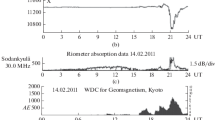Abstract
We have conducted a morphological analysis of near-vertical sounding ionograms. Apart from the main trace, some ionograms feature an additional trace (called “cusp”), which is usually an indicator of traveling ionospheric disturbances. The cusp occurrence rate dependent on the time of the day, average duration and morphological characteristics of these cusps have been studied for winters and summers 2011–2012. The ionosonde recordings taken every minute allowed us to trace the dynamics and evolution of cusps. The use of the bulk of statistical data for processing enabled us to reveal a high rate of cusp occurrence and seasonal characteristics of occurrence of traveling ionospheric disturbances.
Similar content being viewed by others
References
G. H. Munro, “Travelling ionospheric disturbances in the F region,” Aust. J. Phys. 11(1), 91–112 (1958).
G. H. Munro, “Travelling disturbances in the ionosphere,” Proc. Roy. Soc. Lond., A 202(2), 208–223 (1950).
L. H. Heisler, “Anomalies in ionozonde records due to travelling ionospheric disturbances,” Aust. J. Phys. 11(1), 79–90 (1958).
G. H. Munro and L. H. Heisler, “Cusp type anomalies in variable frequency ionospheric records,” Aust. J. Phys. 9(3), 343–358 (1956).
J. Cooper and C. H. Cummack, “The analysis of travelling ionospheric disturbance with nonlinear ionospheric response,” J. Atmos. Terr. Phys. 48(1), 61–64 (1986).
I. V. Krasheninnikov and B. E. Lyannoi, “About interpretation of one type of travelling ionospheric disturbances from ionograms of vertical sounding,” Geomag. Aeronom. 31(3), 427–433 (1991).
A. D. Kalikhman, Doctoral Dissertation in Mathematics and Physics (IrGTU, Irkutsk, 2000).
R. J. Lobb and J. E. Titheridge, “The effects of travelling ionospheric disturbances on ionograms,” J. Atmos. Terr. Phys. 39(2), 129–138 (1977).
A. D. Akchurin, V. V. Bochkarev, V. R. Ildiryakov, and K. M. Usupov, “TID selection and research of its characteristics on ionograms,” in Proc. of the 30th URSI General Assembly and Scientific Symposium (Istanbul, 2011), p. GP1.23.
T. Harris and M. Cervera, “Investigations into small-scale disturbances in the ionosphere using SPICE,” in Proc. of the 30th URSI General Assembly (Istanbul, 2011), p. G07.1.
Author information
Authors and Affiliations
Corresponding author
Additional information
Original Russian Text © V.I. Kurkin, O.A. Laryunin, A.V. Podlesny, M.D. Pezhemskaya, L.V. Chistyakova, 2014, published in Optika Atmosfery i Okeana.
The article was translated by the authors.
Rights and permissions
About this article
Cite this article
Kurkin, V.I., Laryunin, O.A., Podlesny, A.V. et al. Studying morphological characteristics of traveling ionospheric disturbances with the use of near-vertical ionospheric sounding data. Atmos Ocean Opt 27, 303–309 (2014). https://doi.org/10.1134/S1024856014040095
Received:
Published:
Issue Date:
DOI: https://doi.org/10.1134/S1024856014040095




